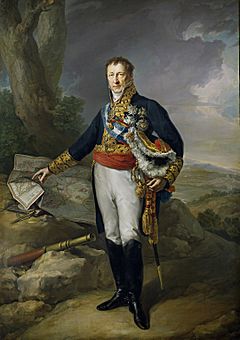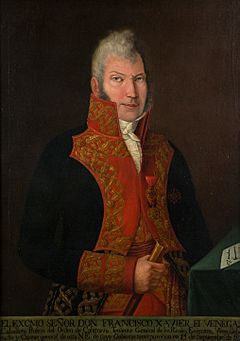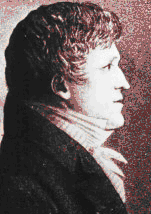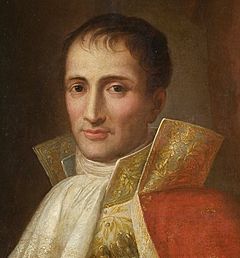Battle of Uclés (1809) facts for kids
The Battle of Uclés happened on January 13, 1809. It was a fight during the Peninsular War where French soldiers, led by Marshal Claude Perrin Victor, easily defeated a Spanish army commanded by Francisco Javier Venegas. The French won a big victory, capturing more than half of the Spanish foot soldiers.
Uclés is a town in Spain, about 15 kilometers (9.3 miles) east of Tarancón and 100 kilometers (62 miles) southeast of Madrid. This battle was part of the larger Napoleonic Wars that took place across Europe.
Quick facts for kids Battle of Uclés |
|||||||
|---|---|---|---|---|---|---|---|
| Part of the Peninsular War | |||||||
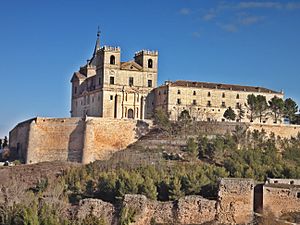 Venegas watched the battle from the monastery in Uclés |
|||||||
|
|||||||
| Belligerents | |||||||
| Commanders and leaders | |||||||
| Units involved | |||||||
| Strength | |||||||
| 15,500 | 11,300 | ||||||
| Casualties and losses | |||||||
| 200 | 7,000 | ||||||
Contents
Why the Battle Happened
Napoleon's Invasion of Spain
In late 1808, Emperor Napoleon of France led a huge army into Spain. He quickly defeated the Spanish forces and took control of Madrid, the capital city. However, a British army, led by General John Moore, arrived in Spain. This made Napoleon change his plans. He ordered his army to chase the British into northwest Spain.
With many French soldiers busy chasing the British, the Spanish armies started to get stronger again. In December 1808, a Spanish army called the Army of the Center, led by Pedro de Alcántara Álvarez de Toledo, 13th Duke of the Infantado, slowly moved towards Madrid. This worried the few French soldiers guarding the capital.
Spanish Plans and French Reactions
The Spanish commander, Infantado, sent his officer Venegas with a strong group of soldiers to bother the French. Venegas won a small fight at Tarancón. In response, the French commander Victor gathered his troops and marched against Venegas in mid-January 1809.
Venegas, without clear orders or support from Infantado, decided to defend a strong position at Uclés. This turned out to be a bad idea. Victor's French army easily defeated the Spanish defenders. Many Spanish soldiers were trapped and captured. Infantado gathered the remaining Spanish soldiers and retreated into the mountains. However, he lost many of his cannons. Infantado was blamed for the defeat and removed from his command.
How the Battle Unfolded
French and Spanish Armies
After Napoleon left Spain to deal with other issues, his brother Joseph Bonaparte, who was the King of Spain, and Marshal Jean-Baptiste Jourdan were worried. They had fewer soldiers around Madrid. The French forces included about 28,000 foot soldiers and 8,000 horsemen.
The Spanish Army of the Center had been resting and reorganizing at Cuenca. Their commander, Infantado, decided to attack Madrid before his army was fully ready.
Venegas's Advance
On December 25, 1808, Infantado sent Venegas with some soldiers to take Tarancón. Another group of Spanish soldiers moved towards Aranjuez but decided not to attack the French there. Venegas managed to surround a French cavalry group in Tarancón. However, the French horsemen quickly escaped, though they lost some men.
Meanwhile, a French marshal named Lefebvre made a big mistake. He was supposed to guard a bridge but instead marched his troops far away to Ávila. This made King Joseph very angry, and Napoleon removed Lefebvre from his command.
With the French forces spread out and the Spanish army threatening Madrid, King Joseph and Jourdan were very worried. But Infantado, the Spanish commander, didn't act quickly. He spent time making complicated plans instead of giving Venegas clear orders.
French Attack on Uclés
On January 12, Victor marched with about 12,000 foot soldiers and 3,500 horsemen. When Venegas heard the French were coming, he pulled back to Uclés. He asked Infantado for instructions, but none came. Infantado sent a few more soldiers but didn't say when he would arrive.
Venegas had doubts about fighting Victor, but he decided to stand his ground at Uclés. He had about 9,500 foot soldiers, 1,800 horsemen, and five cannons. Many of his units were not very confident.
On January 13, Victor's army marched towards Uclés. Victor sent one part of his army to attack the Spanish from the front. He sent another part, led by General Ruffin, to go around the Spanish army and attack them from the side and rear.
The French attacked the Spanish left side first, pushing them back quickly. From his position at the monastery in Uclés, Venegas tried to send help, but it was too late. The French soon reached the walls of Uclés.
When Victor saw his attack was working, he ordered another part of his army to attack the Spanish right side. Since many Spanish soldiers had been moved to the left, this attack easily broke through. Soon, Venegas's entire force was retreating.
Ruffin's French division, which had taken a longer route, arrived perfectly in the Spanish rear. The French cavalry chased the fleeing Spanish soldiers right into Ruffin's waiting troops. Most of the Spanish foot soldiers were trapped and had to surrender.
Aftermath of the Battle
The French captured many Spanish soldiers: four generals, 17 colonels, 306 other officers, and 5,560 regular soldiers. They also took four cannons and 20 flags. About 1,000 Spanish soldiers were killed or wounded. The French reported about 200 casualties.
After the battle, the French soldiers caused a lot of damage in Uclés. They attacked the town and killed many civilians. Monks were especially targeted because some French soldiers claimed they had fired at them. The Spanish prisoners were also treated very badly. Many who couldn't keep up during the march to Madrid were killed by their captors.
Infantado, with his remaining 9,000 soldiers, heard about the disaster at Uclés and quickly retreated. He abandoned his supplies and cannons. A French cavalry group later captured 15 of his cannons.
After taking Cuenca, Victor realized the Spanish army was too far away to chase. He then looked for another Spanish division but it also retreated. Napoleon, feeling confident after the victory at Uclés, allowed his brother Joseph to make a grand entry into Madrid on January 22. Joseph's Spanish subjects were forced to promise loyalty to their new king.
Infantado was removed from his command for not supporting Venegas. Another general took over the Army of the Center. The next major battle in the area was the Battle of Ciudad Real in March 1809.
See also
 In Spanish: Batalla de Uclés (1809) para niños
In Spanish: Batalla de Uclés (1809) para niños



